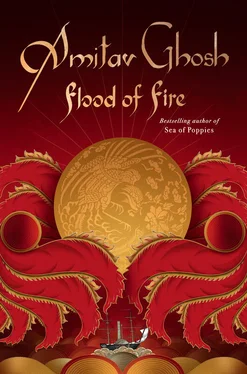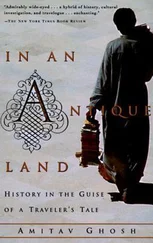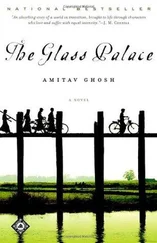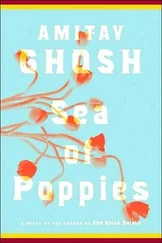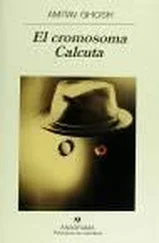All this happened very quickly, amidst an atmosphere of rising tension and uncertainty in Guangdong. Neel had a hazy idea that something significant was afoot but had no inkling of what it was. Then, on the morning of 14 August, Compton told him that Zhong Lou-si was proceeding towards Macau in person and had decided to include Neel in his entourage. Since Macau had a large number of people from Xiao Xiyang — Goa — it was thought that his services might be required.
Zhong Lou-si and his entourage left Guangzhou that afternoon. Their boat made its way southwards through the inland channels of the delta and brought them to their destination the next day. They landed slightly above the barrier that separated Macau from the rest of the mainland.
The barrier consisted of a heavily fortified wall that arced over the narrow but rugged isthmus that joined the mainland to Macau. On the mainland side the isthmus rose steeply, to a peak that commanded a panoramic view of the Portuguese settlement: from there the curved, tapering peninsula could be seen vanishing into the water like the tail of a gargantuan crocodile.
The area was familiar to Neel: during earlier visits to Macau he had often strolled up to the barrier. On a couple of occasions he had even walked through the gateway, advancing a good distance into the Province of Guangdong: in those days the customs house at the gate was but a sleepy little outpost; the guards would allow sightseers to go through in exchange for a few cash-coins.
Now, approaching the wall from the mainland side, Neel saw that the barrier’s fortifications had been greatly strengthened: a large battery of cannon had been placed along the embrasures and a huge military encampment had appeared on the slope above, with rows of tents ranged behind fluttering banners.
Although Neel asked no questions it was evident to him that a military action was imminent.
*
When Kesri heard that a steamer had taken a group of officers — Captain Mee among them — to Macau for a reconnaissance mission, he guessed that a fight was in the offing. This was confirmed when the Enterprize came paddling back to Saw Chow: within a few minutes Kesri received a summons from Captain Mee.
‘The men must be ready to embark early tomorrow morning,’ the captain told Kesri. ‘A transport vessel will come for us soon after dawn — the Nazareth Shah.’
At Macau the officers had seen much evidence of warlike preparations by the Chinese, said Captain Mee. They had deployed a large force just above the barrier; in addition a fleet of war-junks had appeared in the inner harbour. There was every sign that the Portuguese colony was shortly to be attacked, an eventuality that Captain Smith, the CO of the southern theatre, was determined to prevent. Accordingly he had decided to launch a pre-emptive action to disperse the Chinese forces. The ground attack was to be led by a detachment of one hundred and ten Royal Marines, supported by ninety armed seamen from the frigate Druid . The Bengal sepoys would accompany the assault force to provide support if needed. They would embark the next day with only a small detachment of essential camp-followers — gun-lascars, bhistis and a medical team; the sepoys’ baggage was to be packed as per Light Marching Orders.
Kesri lost no time in summoning the company’s naiks and lance-naiks: they had practised so many embarkation drills that everyone knew what had to be done.
Next morning reveille was sounded early but the Enterprize was late in arriving so the sepoys had to endure a long wait under the hot sun. But once the embarkation started it went off without mishap: towed by the Enterprize , the sepoys’ transport ship drew close to the tip of the Macau promontory in the late afternoon. Several British vessels were already assembled there: two eighteen-gun corvettes, Hyacinth and Larne , a cutter, Louisa , a few longboats and the forty-four-gun frigate Druid .
Together the British vessels rounded the tip of the promontory and dropped anchor in the Inner Harbour, on the western side of the city, facing the Praya Grande. Ranged opposite them, to the north, where the peninsula joined the mainland, were a dozen or more war-junks and a flotilla of smaller craft. It was evident to Kesri that these ungainly-looking vessels would be no match for modern warships, yet the very strangeness of their appearance, with castellations perched on the prow and stern, bred a certain disquiet, as did the inexplicable bursts of activity that broke out on their decks from time to time, accompanied by gongs, bells, clouds of smoke and massed voices, shouting in chorus. These peculiar outbursts put the sepoys’ nerves on edge.
In the distance, on the ramparts of the Macau barrier, there was a large battery of cannons and ginjalls — tripod-mounted swivel guns, six to fourteen feet long. Beyond the barrier lay a steep slope on which hundreds of pennants and banners were fluttering in the breeze: Kesri reckoned that a few thousand men were bivouacked up there. After nightfall cooking-fires began to glow all over the slope, creating a curious, glimmering effect, like that of fireflies lighting up a tree. It was clear also, from the traceries of light that kept zigzagging across the campsite, that fresh orders were circulating constantly in the hands of runners with torches.
On the Chinese ships too there were signs that preparations were continuing through the night: the water’s soft lapping was pierced every now and again by shouted commands and the sound of gongs.
When daylight broke it was seen that the war-junks had moved closer to the shore. They were anchored in a protective cluster around the projecting walls of the barrier. The battery on the battlements had also been augmented overnight and there were now some two dozen guns ranged along the parapet.
Through the morning Captain Mee and the other senior officers surveyed the defences, steaming back and forth, abreast of the shore, on the Enterprize . It was noon when the signal for the commencement of the attack was hoisted.
The operation began with the Louisa , the Enterprize and the two eighteen-gun corvettes converging on the barrier and taking up positions facing the Chinese vessels. The Enterprize went in so close to shore as to actually thrust her nose into the mud. Then, upon the hoisting of another signal, the warships opened fire from a range of six to eight hundred yards.
As the roar of cannon-fire rolled across the water flocks of waterbirds took wing, darkening the sky. Within minutes, the Chinese gunners were returning fire, even as cannonballs slammed into the battlements around them. For a while they kept up a spirited but erratic fusillade, with most of their shots sailing over their targets. Then, as the corvettes’ thirty-two-pounders found their range, they began to fall silent, one by one, amidst explosions of shattered masonry and dismembered limbs.
Under cover of the bombardment the Druids marines and small-arms’ men had already boarded a couple of longboats. Now, a signal went up on the frigate’s foremast summoning the Enterprize . With a frantic churning of her paddle-wheels the steamer reversed out of the mud and turned her bows around. Pulling up to the Druid , she took the longboats in tow and went steaming past the barrier to the spot that had been chosen for the landing — a beach on the mainland part of the shoreline, from where the Chinese position could be attacked from the rear.
For a while the landing force disappeared from view, vanishing behind a curve in the shoreline. When Kesri next spotted the red-coated soldiers they were coming over the top of a spur, in double column, with the marines on the outer flank. Their position was exposed to the heights above as well as to battery on the barrier. Coming over the ridge they ran into heavy matchlock- and cannon-fire. Then detachments of Chinese troops began to advance on them from two sides.
Читать дальше
